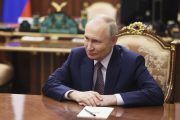
The event officially designated as “The 2010 Review Conference of the Parties to the Treaty on the Non-Proliferation of Nuclear Weapons (NPT)” opened on May 3 at UN Headquarters in New York. The conference, which is expected to host representatives from more than 100 countries, will run through May 28.
The 189 nations that are treaty members meet every five years to discuss new methods to implement and enforce the NPT. Of the world’s independent nations, only four countries are not treaty members: India, Pakistan, North Korea, and Israel, all of which have nuclear arsenals or weapons programs, though Israel has not officially acknowledged its nuclear arsenal.
Most official speakers are the nations’ Ministers of Foreign Affairs or Secretary of State; the only head of state to address the conference will be Iranian President Mahmoud Ahmadinejad.
AP reported that as he departed from Tehran on May 2, Ahmadinejad indicated he would strongly oppose U.S.-led efforts to impose a new round of UN sanctions on his country for refusing to stop its enrichment program. The United States and it allies have asserted that the Iranian program is meant to produce the nuclear fuel for bombs in violation of Iran’s Nuclear Nonproliferation Treaty (NPT) obligations.
"Under the pretext of prevention of nuclear weapons proliferation, they impose heavy pressures on independent countries," Ahmadinejad complained to reporters.
Iran’s Press TV reported that Ahmadinejad’s message to the UN nuclear disarmament conference is that "Iran will not give up even a portion of its inalienable nuclear rights," Vice President Lotfollah Forouzandeh was quoted by Fars News as saying on May 3.
Forouzandeh added that Ahmadinejad’s New York visit also "conveys the Iranian nation’s message of peace and friendship to the world and shows that the Islamic Republic is empowered more than ever, while the global arrogance is weakened."
U.S. Secretary of State Hillary Rodham Clinton, reported AP, suggested over the weekend that Ahmadinejad was coming to New York "to divert attention and confuse the issue." "We’re not going to permit Iran to try to change the story from their failure to comply [with the NPT],” said Clinton.
The home page of the UN website for the 2010 Review Conference of the NPT parties prominently features a quote from United Nations Secretary-General Ban Ki-moon in his address to the East-West Institute on October 24 2008: "A world free of nuclear weapons would be a global public good of the highest order."
Reading some of the background information posted on this official UN site is an excellent education into the mindset of those promoting disarmament treaties. For example:
The NPT is a landmark international treaty whose objective is to prevent the spread of nuclear weapons and weapons technology, to promote co-operation in the peaceful uses of nuclear energy and to further the goal of achieving nuclear disarmament and general and complete disarmament. The NPT represents the only binding commitment in a multilateral treaty to the goal of disarmament by the nuclear-weapon States.
The “History of the Treaty” also serves to trace the progression from the controversial use of atomic weapons by the United States against Japan at the end of World War II, through the so-called arms race between the United States and the Soviet Union during the Cold War, to proposals for nuclear non-proliferation and disarmament though UN administration. One interesting entry, enlightening for those who always thought that only Democrats proposed giving control over nuclear weapons to the UN:
In December 1953, US President Dwight D. Eisenhower in his “Atoms for Peace” proposal, presented to the eighth session of the United Nations General Assembly, urged that an international organization be established to disseminate peaceful nuclear technology, while guarding against development of weapons capabilities in additional countries. His proposal resulted in 1957 in the establishment of the International Atomic Energy Agency (IAEA), which was charged with the dual responsibility of promotion and control of nuclear technology.?
Curiously, the same historic review failed to mention an even more significant nuclear arms-control scheme proposed by Eisenhower’s successor, which occurred on on September 25, 1961, when President John F. Kennedy presented to the 16th General Assembly of the United Nations a disarmament proposal entitled, Freedom from War: The United States Program for General and Complete Disarmament in a Peaceful World (State Department Publication 7277).?? Excerpts from the document include:
• "Disarmament shall take place as rapidly as possible until it is completed in [a program of three] stages containing balanced, phased and safeguarded measures, with each measure and stage to be carried out in an agreed period of time."
??• "As states relinquish their arms, the United Nations shall be progressively strengthened in order to improve its capacity to assure international security and the peaceful settlement of differences as well as to facilitate the development of international cooperation in common tasks for the benefit of mankind."?
• "By the time Stage II [of the three-stage disarmament program] has been completed, the confidence produced through a verified disarmament program, the acceptance of rules of peaceful international behavior, and the development of strengthened international peace-keeping processes within the framework of the U.N. should have reached a point where the states of the world can move forward to Stage III. In Stage III progressive controlled disarmament and continuously developing principles and procedures of international law would proceed to a point where no state would have the military power to challenge the progressively strengthened U.N. Peace Force and all international disputes would be settled according to the agreed principles of international conduct." (Emphasis added.)
Demonstrating that the spirit of 7277 is still alive, the current 2010 Review Conference page notes:
The Review Conference is expected to consider a number of issues, including those discussed at the 2005 Conference: universality of the Treaty; nuclear disarmament, including specific practical measures; nuclear non-proliferation, including the promoting and strengthening of safeguards; measures to advance the peaceful use of nuclear energy, safety and security; regional disarmament and non-proliferation; implementation of the 1995 resolution on the Middle East; measures to address withdrawal from the Treaty; measures to further strengthen the review process; and ways to promote engagement with civil society in strengthening NPT norms and in promoting disarmament education. (Emphasis added.)
It is curious that the solution proposed for possible development of nuclear weapons by a few rogue states such as Iran and North Korea is to place the nuclear arsenals of all the world’s nations (including the United States) under UN control.
However, neither should such a proposal be surprising, since virtually all conventional military operations that the United States has engaged in since the Korean War, right up to and including Afghanistan, have been entered into with the consent and control of one UN agency or another.
Photo: Iranian President Ahmadinejad at NPT conference at UN Headquarters: AP Images




